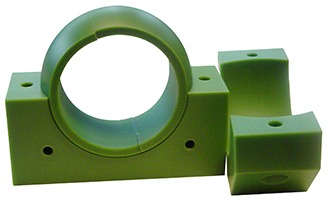
Performance plastics offer a solution to friction by having a significantly lower coefficient of friction than metals because they are softer and more flexible, which is the key in reducing heat and wear. Self-lubrication and the excellent mechanical properties of performance plastics also provide resistance to corrosion and abrasion.
When selecting a plastic material for an application requiring a reduction in abrasion or where self-lubrication is desired, such as a part that is not easily accessed for maintenance, there are some things to consider.
Pressure (P) and sliding speed or velocity(V) are key factors in determining the most optimal material. If the PV values of an application are especially demanding in a sliding application the use of a high-temperature plastic is the most optimal choice.
If the application requires FDA approval, chemical resistance, detectability, high-load bearing capabilities, water dissipation, or extreme hot or cold resistance – this is all possible with many grades and materials that are well suited in various price ranges. A performance plastic distributor can help you choose which material is best.

Switching to a plastic material has added benefits other than simply reducing friction and wear as well. It also can translate to higher production speeds, reduced noise, less energy consumption, increased safety and less fuel consumption. Benefits also come from the manufacturing of the parts themselves with less machining time and moldability options, which can reduce the cost of the part.
With cost savings, increased profits as well as safety improvements, it’s time to switch to performance plastics.

